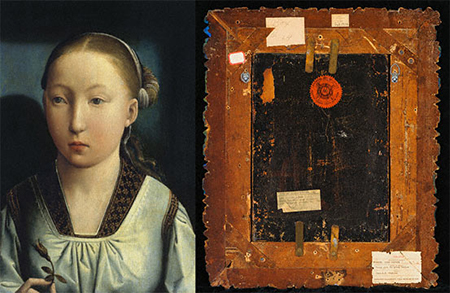
Continuing through August 14, 2016
When exploring the halls of a museum and viewing the works of Old Master painters in person for the very first time, rather than projected in dark art history lecture halls or reproduced in glistening color on glossy pages of an art history book, it is easy to forget that we are only privy to one side of the painting’s story. While we can gather fragments of the painting’s history when looking at the painted image, we are limited to viewing the work from a single vantage point. What if we could turn the painting over to reveal its entire history?
The markings, stamps, and authentication badges placed on the backside are like stamps in a passport. They reveal the complete journey of the artwork. Furthermore, these markings are of the utmost importance to museums to determine the provenance, collections' stewardship authenticity, and conservation of a work. The purpose of “Sub Rosa: Behind the Scenes at the Museum” is to reveal these inner workings of a museum. For the first time, a selection of the Museum’s Old Master paintings is installed facing the wall so that the backs of the canvases precisely to expose their frequently decaying condition or questionable provenance. And it serves to refresh and illuminate our appreciation of what we know to be, in this case, hidden from sight.
Derived from the Latin “under the rose” to indicate an “emblem of secrecy,” the term sub rosa refers to that which is “done in secret.” By revealing the backs of the paintings, the museum consents to share the entire journey that every artwork undergoes to engage in a dialogue with art history professionals, novices, students and collectors about the inner workings and practices of the institution.
One such example is a late 15th Century oil on panel “Portrait of an Infanta” by Belgium artist Juan de Flandes. The portrait, housed in an ornate wood frame, captures a somber young woman whose vacant eyes wander, avoiding our gaze. The back of the painting, however, reveals a much more complex narrative through the stickers and labels of various origin affixed to the weathered frame. On the top of the frame, a handwritten sticker bears the box or crate number that the work was originally stored in, while a smaller, typed sticker for the Fogg Museum of Art at Harvard University indicates the loan number. A vibrant red serrated circular sticker officiated by the American Art Galleries Madison Square South New York suggests that the Fogg Museum may have sought authentication in New York. Other labels applied to the back identify the work as “early French or Flemish” and was lent by Robert Minturn, Esq. in ’34.
“Portrait of an Infanta” is just one example of the extensive documentation, categorization and authentication that a single painting must undergo before it is ever exposed to the public. By turning the museum inside out as it were, “Sub Rosa” illuminates the journey an art object, particularly if historical, must undertake prior to being presented to we, the public. It also serves as a reminder of the need for security from fraud not only as it relates to the value of important works of art, but to protect the integrity of the historical narrative.
Published Courtesy of ArtSceneCal ©2016
